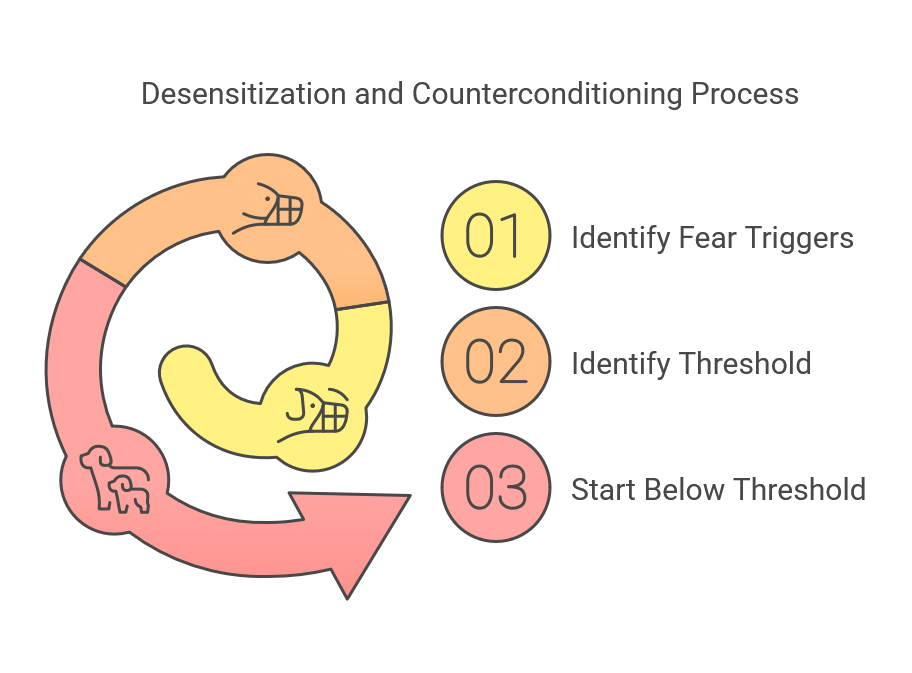Table of Contents
Introduction
Dogs, like humans, thrive on confidence. A well-adjusted dog approaches new experiences with curiosity rather than fear, making them easier to train, socialize, and integrate into daily life. However, many dogs struggle with fear-based behaviors due to genetics, early experiences, trauma, or medical conditions.
For pet parents of fearful dogs, the challenge is real—but so is the solution. This guide breaks down the science behind canine fearfulness and provides structured, effective strategies to build a dog’s confidence through positive reinforcement and controlled exposure.
1. Why Are Some Dogs Fearful?
Understanding the root causes of fear is the first step in helping a dog overcome it. Several factors contribute to fearfulness in dogs:
Genetics & Breed Predisposition
Certain breeds are naturally more sensitive or anxious than others. For example, Shetland Sheepdogs, Border Collies, and Greyhounds are known for being more reserved, while Labrador Retrievers and Golden Retrievers tend to be more outgoing. A study published in the journal Scientific Reports (source) found that fear-related behaviors in dogs have a significant genetic component, meaning some dogs are simply more predisposed to nervousness.
Early Socialization & Life Experiences
The critical socialization window for puppies occurs between 3 to 14 weeks of age. During this time, exposure to different environments, people, and other animals plays a crucial role in shaping their confidence. Puppies who miss out on positive early experiences due to neglect, isolation, or illness often develop lifelong fear-based behaviors.
Research from the American Veterinary Society of Animal Behavior (source) highlights the importance of early and controlled socialization, stating that puppies who are not exposed to a variety of stimuli in a positive manner are significantly more likely to become fearful dogs.
Trauma & Negative Experiences
Rescue dogs, in particular, may develop deep-seated fears due to past abuse, neglect, or traumatic events. Loud noises, harsh training methods, or unpredictable environments can reinforce fear-based behaviors, making recovery a slow and patient process.
Medical Conditions & Anxiety Disorders
Sometimes, fearfulness in dogs stems from underlying medical conditions. Pain, neurological disorders, or sensory impairments (such as vision or hearing loss) can make a dog more anxious in unfamiliar situations. It’s crucial to rule out medical issues before assuming a dog’s fear is purely behavioral. A veterinary examination, including bloodwork and a comprehensive health assessment, can help identify any underlying conditions that may be contributing to the dog’s anxiety.
2. Signs of a Fearful Dog
Identifying fear-based behaviors is crucial for addressing them properly. Fear in dogs can manifest in subtle ways or escalate into more severe reactions.
Physical Signs of Fear
- Tense body posture with a lowered head
- Tucked tail or tail held stiffly
- Ears pinned back against the head
- Excessive panting, drooling, or shaking
- Avoidance behaviors (turning away, hiding, or cowering)
Behavioral Indicators
- Excessive barking or whining in response to new stimuli
- Submissive urination when approached by people or other dogs
- Pacing, restlessness, or escape attempts
- Refusal to take treats in a stressful environment (a sign of severe fear)
Extreme Fear Responses
- Defensive aggression (growling, snapping, or lunging)
- Freeze response (becoming stiff and unresponsive)
- Shutdown behavior (refusing to move, eat, or engage)
A fearful dog’s body language often provides clear warnings before escalating into aggressive or reactive behavior. Recognizing these early signs allows owners to intervene before fear turns into panic or aggression.
For a comprehensive guide to dog body language, refer to the ASPCA’s behavioral resources (source).

3. How to Build Confidence in Fearful Dogs
Helping a fearful dog develop confidence is a gradual process that requires patience, consistency, and positive reinforcement. Here’s a step-by-step guide to setting them up for success.
1. Create a Safe & Predictable Environment
Fearful dogs need security and stability in their daily lives. An unpredictable environment reinforces anxiety, while structure and routine help them build trust.
- Provide a safe space – A designated quiet area (such as a crate or a cozy corner) gives fearful dogs a retreat when overwhelmed. Using calming aids like pheromone diffusers (Adaptil) or white noise machines can further promote relaxation.
- Establish a routine – Feeding, walking, and training at consistent times reduces uncertainty and builds confidence. Dogs thrive on predictability.
- Use a soft voice and calm body language – Sudden movements or loud corrections can exacerbate fear. Instead, use a reassuring but neutral tone to build trust.
2. Gradual Socialization & Exposure Training
Introducing fearful dogs to new experiences must be done at their own pace. Flooding them with too much, too soon, can have the opposite effect—reinforcing fear instead of reducing it.
- Start with distance – If a dog is afraid of strangers, begin by letting them observe from afar. Reward calm behavior and gradually decrease the distance over time.
- Use positive reinforcement – Pair new experiences with rewards. For example, if a dog is hesitant around bicycles, reward any calm interaction with high-value treats.
- Monitor body language – Look for signs of stress escalation. If the dog starts showing fear signals, step back and allow them to regain confidence before proceeding.
For more on proper dog socialization techniques, refer to the American Kennel Club’s guide (source).
3. Teach Basic Obedience & Confidence-Boosting Games
Training gives fearful dogs a sense of control over their environment. When they learn to associate commands with rewards, they become more confident in their ability to navigate the world.
- Basic commands like “sit,” “stay,” and “come” provide structure and predictability.
- Nose work and puzzle games encourage problem-solving and independent thinking.
- Agility-style obstacles (like stepping over low hurdles) build physical confidence and trust in their handler.
The Fear Free® Pets program (source) offers science-based training methods designed to help fearful dogs build confidence in a stress-free way.
4. Desensitization & Counterconditioning: Overcoming Fears Step by Step
For fearful dogs, exposure to scary situations can either build confidence or reinforce fear, depending on how it’s handled. The key is gradual exposure paired with positive experiences—a technique called desensitization and counterconditioning.
Step 1: Identify Triggers & Set a Threshold
- Observe what specific situations trigger fear (e.g., loud noises, strangers, car rides).
- Identify the threshold—the point where the dog begins showing fear responses (tensing up, backing away, freezing).
- Start BELOW the threshold—exposing the dog to a low-intensity version of the trigger.
For example:
- If a dog is scared of vacuum cleaners, begin by leaving it turned off in the room while the dog receives treats.
- If a dog fears strangers, start by letting them observe from a comfortable distance without direct interaction.
Step 2: Pair the Trigger with Positive Reinforcement
- Use high-value treats or favorite toys to create positive associations with the feared stimulus.
- Keep sessions short and stress-free—if the dog shows any signs of distress, move back a step.
- Over time, gradually increase exposure (e.g., turning the vacuum on at a distance while treating).
Step 3: Build Confidence through Repetition
- Daily practice in controlled, short sessions leads to long-term improvement.
- Reward bravery, ignore fear—celebrate small wins, but avoid forcing the dog to engage before they’re ready.
🐶 Resource: The American Society for the Prevention of Cruelty to Animals (ASPCA) provides a detailed guide on counterconditioning for fear-based behaviors (source).

5. Confidence-Boosting Mistakes to Avoid
Even with the best intentions, some actions can accidentally reinforce fear in dogs. Avoid these common confidence-killing mistakes:
❌ 1. Forcing a Fearful Dog into Uncomfortable Situations
- Example: Dragging a scared dog toward a stranger or forcing them into a dog park.
- Why it’s harmful: Flooding a dog with overwhelming stimuli can backfire, worsening fear and breaking trust.
- Solution: Use gradual exposure techniques instead.
❌ 2. Inconsistent Responses to Fear
- Example: Sometimes comforting a fearful dog and sometimes ignoring their fear.
- Why it’s harmful: Dogs thrive on predictability. Mixed signals confuse them, making training ineffective.
- Solution: Always use calm, neutral behavior and reinforce brave moments rather than fear responses.
❌ 3. Using Harsh Corrections or Punishment
- Example: Yelling, leash jerking, or using shock collars to “correct” fear-based reactions.
- Why it’s harmful: Punishing fear doesn’t stop fear—it makes the dog associate fear with punishment, worsening anxiety.
- Solution: Use positive reinforcement to shape desired behaviors.
❌ 4. Over-Reliance on Comforting Without Encouraging Independence
- Example: Constantly holding, petting, or babying a fearful dog.
- Why it’s harmful: While affection is great, over-reassurance can reinforce fearful behaviors.
- Solution: Teach the dog to navigate fears on their own by reinforcing bravery instead of coddling.
🐕 Tip: If you’re unsure whether you’re reinforcing fear or helping your dog, check out the Fear Free® Pets training methodology (source), which focuses on science-based, stress-free training.
6. When to Seek Professional Help
While many fearful dogs improve with structured confidence-building techniques, some cases require expert intervention.
Signs That Professional Help is Needed
- Extreme Fear That Interferes with Daily Life
- The dog refuses to leave the house, walk on a leash, or engage in normal activities.
- Fear Escalates to Aggression
- If a fearful dog growls, snaps, or bites in response to triggers.
- Persistent Anxiety Despite Training
- Even after weeks of gradual exposure, the dog remains highly reactive or distressed.
- Severe Separation Anxiety
- The dog panics when left alone, leading to destructive behaviors or self-injury.
Types of Professional Support Available
- Veterinarian:
- Medical issues (pain, hormonal imbalances, or neurological conditions) can cause fear-related behaviors. A vet check ensures there are no underlying health problems.
- Certified Canine Behaviorist or Trainer:
- A Certified Applied Animal Behaviorist (CAAB) or Fear Free® Certified Trainer specializes in treating deep-seated fear responses.
- Find a certified trainer via: International Association of Animal Behavior Consultants (IAABC)
- Veterinary Behaviorist (Diplomate of the ACVB):
- For severe cases, a board-certified veterinary behaviorist can prescribe anti-anxiety medications alongside a behavior modification plan.
- Find a veterinary behaviorist via: American College of Veterinary Behaviorists (ACVB)
Conclusion:
Helping fearful dogs build confidence isn’t an overnight process—it’s a journey of patience, trust, and positive reinforcement. Every small victory, whether it’s a dog taking a step toward a previously feared object or calmly observing a new visitor, is a step toward resilience.
By using safe environments, gradual exposure, positive reinforcement, and structured training, pet parents can empower their dogs to navigate the world with greater assurance. The key is consistency—every day, every interaction, and every reward contributes to a dog’s long-term confidence.
Final Key Takeaways
✔ Confidence-building is a gradual process—never rush it.
✔ Safe environments and predictable routines reduce fear.
✔ Desensitization and counterconditioning help reframe fearful triggers.
✔ Avoid common mistakes like forcing situations or using punishment.
✔ Some fear-based behaviors require professional intervention.
Your dog’s fear isn’t a reflection of their worth—it’s a challenge that, with time and care, can be overcome. Celebrate small wins, be patient, and trust the process.
🐶 Looking for more expert resources?
- Fear Free® Pets Training – fearfreepets.com
- ASPCA Behavior Resources – aspca.org
- American College of Veterinary Behaviorists (ACVB) – dacvb.org
FAQs:
1. How long does it take for a fearful dog to gain confidence?
It varies—some dogs show improvement within weeks, while others may take months or even years to fully build confidence. Progress depends on factors like past trauma, breed tendencies, and consistency in training. The key is to go at the dog’s pace and avoid rushing the process.
2. My dog is afraid of everything—where do I start?
Start by creating a stable, predictable environment. Establish a daily routine, provide a safe space, and introduce confidence-building activities like treat puzzles, nose work, and structured training. Begin desensitization with mild, low-stress versions of fear triggers and gradually work your way up.
3. Should I comfort my dog when they’re scared, or does that reinforce fear?
It depends on how you comfort them. Calm, neutral reassurance (like being present and offering a treat for bravery) is beneficial, but excessive soothing (like coddling or panicked reactions) can reinforce fear. Instead of saying “It’s okay” in an anxious tone, redirect their focus with a confident, upbeat approach.
4. My dog is afraid of strangers—how can I help?
Introduce strangers gradually and positively. Start with your dog observing from a safe distance while they receive treats for calm behavior. Never force interaction. Over time, reduce the distance, letting the dog decide when to approach. If needed, consult a fear-free certified trainer for guidance.
5. Can professional training help my fearful dog?
Yes! Professional trainers, behaviorists, and veterinary behaviorists can provide personalized guidance for severe fear issues. Look for trainers certified by:
- Fear Free® Pets (fearfreepets.com)
- International Association of Animal Behavior Consultants (IAABC) (iaabc.org)
- American College of Veterinary Behaviorists (ACVB) (dacvb.org)
6. What if my dog’s fear never improves?
Some dogs may always be naturally more cautious, but improvement is always possible. If progress stalls, consider:
- A professional behaviorist’s input
- Medical factors (pain, neurological issues) ruled out by a vet
- Alternative approaches like anxiety wraps, calming pheromones, or prescription anti-anxiety medication
7. Can medication help a fearful dog?
For severe anxiety, veterinary-prescribed medication (like fluoxetine or trazodone) may be recommended alongside behavior modification training. Medication isn’t a “quick fix,” but it can reduce anxiety enough to make training more effective. Always consult a veterinary behaviorist before considering medication.
8. My rescue dog is scared of everything—can they ever be confident?
Yes! Many rescued fearful dogs have successfully gained confidence with patience, positive training, and gradual exposure. While some may always be naturally cautious, they can still learn to navigate the world with greater comfort and security.





Pingback: Signs of Dog PTSD: Recovery Timeline 2025 - Dog Life Expert